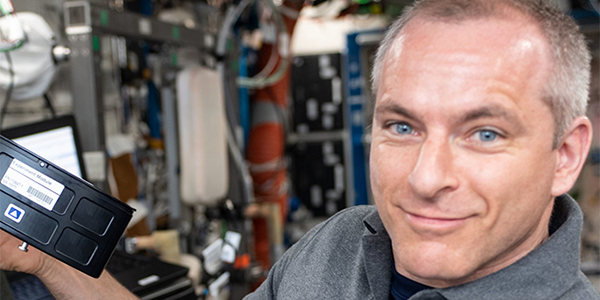Tissue Chip Trio to Orbit Earth for Answers to Osteoarthritis and Muscle Diseases
December 2, 2020
Three NCATS–supported experiments will catch a ride into orbit in early December aboard a SpaceX Dragon 2 spacecraft bound for the International Space Station (ISS). They will explore how to prevent osteoarthritis after joint injuries, what drives muscle wasting, and whether heart tissue damage can be reversed.
Launching from Cape Canaveral, Florida, no earlier than Dec. 5, the experiments will take place inside tiny, bioengineered 3D models of living organs and tissues called tissue chips. The work is funded through the NCATS-led Tissue Chips in Space initiative, a collaboration among the ISS National Lab, NCATS and NIH’s National Institute of Biomedical Imaging and Bioengineering. With the latest launch, NCATS has supported nine tissue chip research projects in space.
“The astronauts on the space station are helping us push the boundaries of biomedical research off the earth, for the earth,” said Lucie A. Low, Ph.D., Scientific Program Manager with NCATS’ Office of Special Initiatives. “The Tissue Chips in Space program is the essence of translational science — we use collaborative team science and innovative technology to overcome research challenges and accelerate the development of therapies for patients.”
Once in space, tissue chips become biomedical time machines. The microgravity environment of low earth orbit compresses disease and aging processes that take years on earth into only weeks or months. That accelerates earthbound scientists’ research into everything from why immune systems change with age to how muscle fibers weaken over time, which may speed the delivery of effective prevention and treatment options to patients in need.
This space flight marks the second trip to the ISS for a tissue chip project created by researchers at Massachusetts Institute of Technology (MIT), Cambridge, with technical assistance from Techshot, Inc. Their research focuses on how to prevent joint injuries in younger adults from progressing to osteoarthritis as they age. Currently, there are no U.S. Food and Drug Administration–approved disease-modifying drugs to prevent or treat post-traumatic osteoarthritis.
“Our objective is to use these complex in vitro microphysiological systems to accelerate disease progression and test therapeutics on earth and in space,” said Alan Grodzinsky, Sc.D., professor of biological, electrical and mechanical engineering at MIT.
The MIT tissue chip will use a matrix of human cartilage, bone and the tissue that lubricates and feeds the joint to test potential osteoarthritis-preventing therapies. The tissue in the chip will undergo a single-impact injury to simulate a traumatic joint injury on earth or in space. The MIT team’s first space-bound tissue chip experiment observed the effects of the ISS’s microgravity on human joints and modelled the cellular and metabolic changes that mimic osteoarthritis. The project also tested the effectiveness of the corticosteroid dexamethasone, which may help resist the release of inflammatory proteins into damaged cartilage. On this return journey, the tissue chip project will pair dexamethasone with the hormone insulin-like growth factor 1 (IGF-1) to see if the combination is effective in slowing the degradation of injured joint tissue. IGF-1 may have the ability to rebuild damaged cartilage and protect the bone layer just below a joint’s cartilage.
“Osteoarthritis is a complex disease with so many involved tissues — bones, cartilage, synovium, even nerves,” Grodzinsky explained. “It’s likely that a combination of therapies will be needed to treat it.”
Two other tissue chip experiments will make their inaugural journeys to the ISS. Researchers at the University of Florida, Gainesville, have worked with technology partner SpaceTango to craft an experiment examining what fuels the degenerative loss of skeletal muscle mass as people age. Their tissue chip will compare how muscle cells from young, healthy people and from older, sedentary donors change in the microgravity of orbit, where accelerated changes in muscle biology may mimic the aging process. Insights from the project could lead to new therapies to treat and even prevent such muscle-wasting diseases as sarcopenia, a disease marked by the steady loss of skeletal muscle mass and strength, primarily in older people.
Researchers at Stanford University will use a three-dimensional model of beating heart tissue to study how microgravity alters cardiac cells’ structure and function. They have teamed with technology partners at BioServe Space Technologies (University of Colorado, Boulder) and at the University of California, Santa Barbara. With cells from a diverse donor population, the scientists will focus on how microgravity triggers cardiac muscle cell weakening. Their findings could help researchers find treatments that reverse or even prevent muscle damage that leads to such conditions as heart failure.
The tissue chip projects will remain on board the ISS for about a month before splashing down back on earth in their SpaceX capsule.
To learn more about how NCATS supports biomedical research on the ISS to speed the delivery of new treatment options for a range of diseases, visit the NCATS Tissue Chips in Space site.



